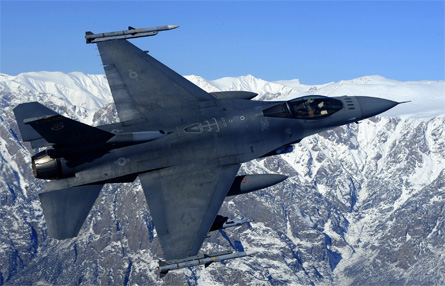Lockheed Martin says that its experience as the original equipment manufacturer (OEM) gives it a decisive edge over would be competitors in upgrading older F-16 models around the world.
"The OEM brings technical certainty," says Bill McHenry, Lockheed's F-16 business development director. Lockheed has over 40 years of experience, and has dedicated labs and data on the F-16, he says.
A competitor, for example Boeing, hoping to modify F-16s would not have that kind of experience or the in-depth technical knowledge of the aircraft. But that would be also be the case if Lockheed were to try to independently upgrade the Boeing F-15 or F/A-18, McHenry says.
"They're working with technical uncertainty," he says. "What that results in is a certain risk."
 |
|---|
©USAF |
As part of the its efforts in developing the QF-16, Boeing recently said that it has reverse engineered much of the structure and avionics of the venerable Lockheed-built jet. Company officials say the experience has given them the confidence to consider upgrading F-16 fleets around the world independent of Lockheed. Boeing has held preliminary talks with a number of potential customers about competing to modify their F-16 fleets.
But technical risks are not the only factor, McHenry says. A custom modification of a relatively small number of aircraft leads to unique configurations that cannot readily be upgraded with a larger pool of aircraft. That robs the customer of economies of scale and cost sharing for further upgrades, he says.
Meanwhile, Lockheed is offering its new F-16V upgrade configuration for the jet. However, it is not a fixed configuration, there are options that customers can choose from, McHenry says.
"You would have this collection of capabilities, of which some customers would pick pieces of that," he says.
For example, the V-configuration offers active electronically scanned array (AESA) radars, however Lockheed does not mandate which type of set a customer picks. The company simply integrates whichever of the two competing designs-either the Northrop Grumman's Scalable Agile Beam radar (SABR) or the Raytheon Advanced Combat Radar (RACR). The same applies to aircraft display systems and other hardware.
"There is no one configuration," McHenry says.
It will be hard work for Lockheed to manage the disparate configurations, but it will be "nirvana" for customers, he says.
The largest customer for the V-configuration is the US Air Force, which is looking at upgrading about 300 of its F-16s. Lockheed is working with the USAF to define the service's requirements, McHenry says.
So far, the USAF knows its wants an AESA array, a new center pedestal display and upgraded electronic warfare systems, but it has not picked specific vendors or finalized the exact configuration it wants. The "intent" is for Lockheed to act as the prime integrator for the upgrades, McHenry says.
The USAF is also gearing up to test theF-16's airframe structure starting around November, McHenry says. The service needs certainty on exactly how much life is left on the jets as it waits for Lockheed's F-35 to become available in numbers.
Taiwan is another prospective V-configuration customer, McHenry says. Overall, the company expects sell about 500 to 600 V-model kits.
Source: Flight International



















